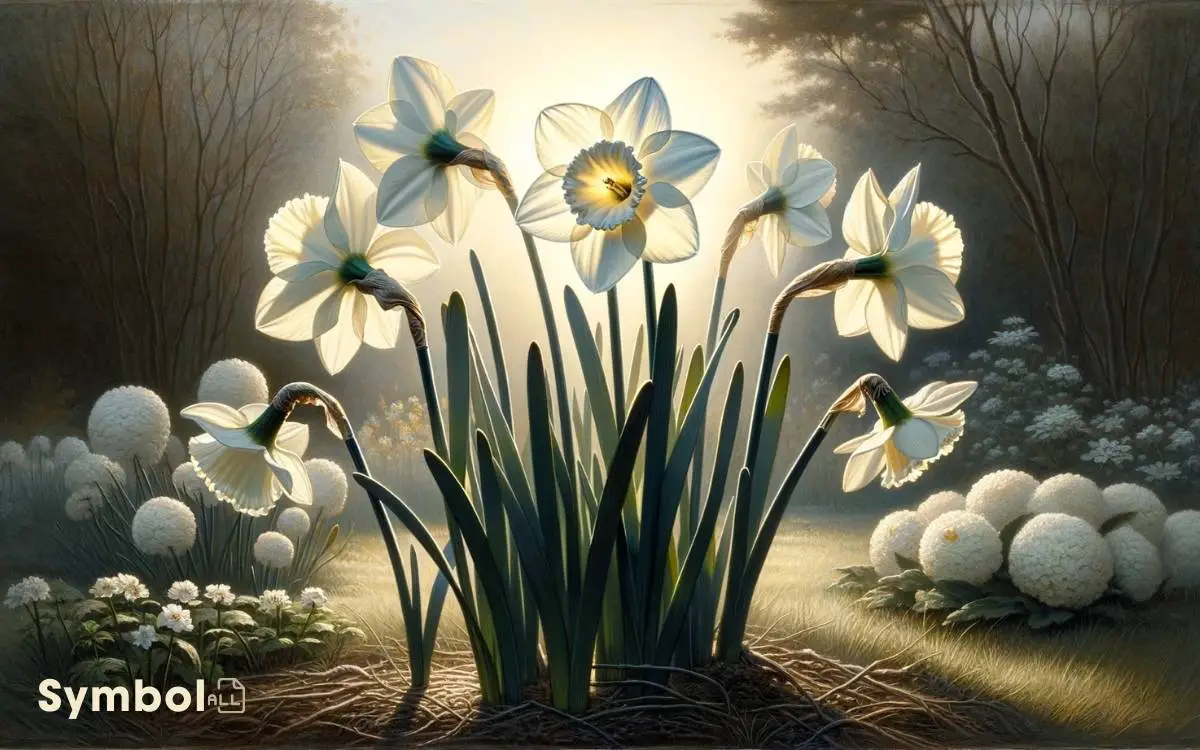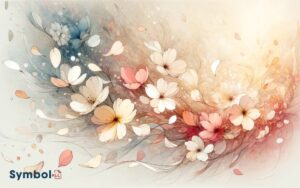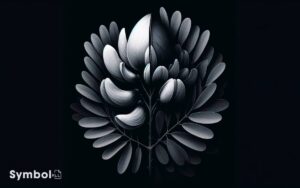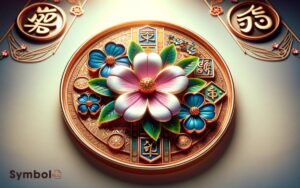What Does the Narcissus Flower Symbolize? Self-Obsession!
The narcissus flower carries rich symbolism, rooted in Greek mythology, where it represents vanity and the peril of self-obsession. Stemming from the tale of Narcissus, it’s intrinsically linked to themes of love, reflection, and caution.
Beyond mythology, it signifies new beginnings, growth, and the cycle of life and death, blooming in early spring as a beacon of renewal.
Culturally, it’s a symbol of wealth, respect, and remembrance, often used in ceremonies to honor those passed away or to celebrate achievements.
It also signifies unrequited love, capturing the essence of longing and solitude. Delving further, you’ll uncover even more layers to its meaning.

Key Takeaways
The Myth of Narcissus
The myth of Narcissus, often recounted in ancient literature, vividly illustrates the origins of the narcissus flower through a tale of beauty, self-obsession, and transformation.
You’re delving into a story where Narcissus, a young man of unparalleled beauty, becomes infatuated with his reflection in a pool of water.
This obsession, driven by his inability to leave the captivation of his image, leads to his demise. He withers away, consumed by his self-admiration, and in his place, a flower blooms bearing his name.
This metamorphosis symbolizes a deep connection between human emotions and botanical phenomena.
The flower that emerges isn’t just a botanical species; it’s a reminder of the fine line between admiration and vanity, serving as a natural representation of the consequences of self-absorption.
Symbol of New Beginnings
While the myth of Narcissus underscores themes of vanity and self-obsession, the narcissus flower also embodies the hopeful notion of new beginnings. This contrast is deeply rooted in the flower’s botanical characteristics and cultural interpretations.
Emerging in the early spring, the narcissus is often the first sign of life in a dormant landscape, symbolizing the awakening of nature and the cycle of renewal.
Scientifically, its perennial growth pattern underscores this symbolism, as the plant returns year after year, resilient through seasonal changes.
Culturally, it’s associated with the Chinese New Year and is regarded as an emblem of prosperity and rejuvenation. Therefore, the narcissus serves as a powerful metaphor for personal growth, resilience, and the promise of a fresh start.
Reflection of Vanity
You’ll find that the Narcissus flower‘s association with vanity has roots in ancient Greek mythology, where its symbolism is deeply intertwined with the story of a young man enthralled by his own reflection.
Modern cultural interpretations have expanded on this theme, examining the flower’s role in art, literature, and everyday language to convey self-obsession.
Additionally, psychologists have explored its significance in understanding human behavior, particularly in the context of narcissism and self-perception.
Origins in Greek Myth
In Greek mythology, Narcissus’s story epitomizes vanity, detailing how his obsession with his reflection led to his transformation into the eponymous flower.
This myth serves as a poignant reminder of the dangers of excessive self-admiration and the importance of looking beyond one’s own reflection.
| Aspect | Description | Symbolism |
|---|---|---|
| Narcissus | Beautiful youth | Vanity, self-obsession |
| Reflection | His own image | Self-awareness, introspection |
| Transformation | Into a flower | Consequences of vanity |
| Echo | Unrequited love | Neglect, ignored affection |
| Flower | Narcissus plant | Renewal, cautionary symbol |
Understanding this mythological origin provides a deeper insight into the narcissus flower’s symbolism, emphasizing the balance between self-love and the awareness of those around us, a theme as relevant today as it was in ancient times.
Modern Cultural Interpretations
The modern interpretation of the narcissus flower continues to reflect themes of vanity and self-obsession, deeply rooted in its mythological origins.
In contemporary contexts, this symbolism has evolved, yet the essence remains unchanged. The flower’s association with Narcissus, who was captivated by his own reflection, underscores a societal observation of individuals consumed by their self-image.
This cultural interpretation leverages the narcissus as a metaphor for the dangers of excessive self-admiration, cautioning against the loss of connection with the world beyond oneself.
Scientally, the plant’s pronounced features, such as its prominent corona, mirror this allegory, representing not just physical beauty but also the introspective reflection that can lead to isolation.
This emblematic use of the narcissus serves as a poignant reminder of the balance between self-love and narcissism.
Psychological Implications
Building on the cultural interpretations of the narcissus flower, it’s important to ponder how its symbolism reflects deeper psychological implications, particularly in the domain of vanity.
The narcissus, with its head bowed as if admiring its reflection, serves as a poignant metaphor for self-absorption. This imagery is deeply entrenched in psychological discourse, especially when discussing narcissistic personality traits.
The flower’s association with vanity isn’t merely superficial; it mirrors the intricate ways individuals may exhibit self-centered behavior, often at the expense of deeper connections.
Understanding this symbolism helps you grasp the nuanced interplay between nature and human psychology, highlighting how even the simplest elements can reveal profound insights into human behavior and societal values.
Emblem of Wealth
Throughout history, the narcissus flower’s opulent appearance has symbolized wealth, often marking the prosperity of those who cultivated or possessed it.
Its vibrant blooms and intoxicating fragrance denote not just physical but also metaphorical richness, reflecting a deep-seated association with fortune and success.
| Era | Region | Significance |
|---|---|---|
| Ancient Rome | Mediterranean | Indicators of affluence |
| Medieval | Europe | Gifts among the wealthy |
| 17th Century | Netherlands | Central in ‘Tulip Mania’ |
| Modern Day | Global | Luxury in floral arrangements |
This change from a luxury commodity to a symbol of opulence across various cultures underscores its enduring appeal and status.
The narcissus represents more than just a flower; it’s a beacon of prosperity, esteemed by those who understand its layered meanings.
Mark of Respect
You’ll find the narcissus flower holds profound significance as a mark of respect across various cultures. Its use in honoring the departed, acknowledging cultural traditions, and serving as a symbol for personal remembrance underlines its multifaceted role.
These aspects highlight the flower’s ability to convey deep respect and memory, bridging the gap between the living and the departed.
Honoring the Departed
In many cultures, the narcissus flower serves as a poignant symbol to honor those who’ve passed, reflecting deep respect and remembrance.
Its role in funerary practices isn’t arbitrary; the flower’s perennial nature and its ability to bloom anew each year symbolize the cycle of life, death, and rebirth.
This makes it a fitting tribute to the deceased, suggesting a belief in the continuity of the soul or spirit beyond physical existence.
You’ll find that in specific traditions, the planting of narcissus around gravesites or the inclusion of these flowers in funeral bouquets carries significant meaning. It’s a way to express sorrow for the loss, yet also a hopeful nod towards regeneration and eternal connection.
Cultural Significance
Honoring with a mark of respect, the narcissus flower embodies deep cultural significance across various societies, symbolizing esteem and admiration for individuals and their achievements. Its presence in ceremonies and traditions highlights a universal regard for the virtues it represents.
Here’s how the narcissus manifests this respect:
- In Scholarly Achievements: Awarded to scholars for outstanding intellectual accomplishments, symbolizing enlightenment and wisdom.
- In Artistic Performances: Often given to artists and performers, recognizing their creativity and contribution to cultural heritage.
- In Public Service: Presented to individuals who’ve dedicated their lives to serving the community, signifying gratitude and respect for their selflessness.
Through these gestures, the narcissus transcends mere floral beauty, becoming a deeply embedded cultural token of honor and recognition.
Personal Remembrance
Beyond its cultural and societal roles, the narcissus flower serves as a poignant symbol of personal remembrance, embodying the respect and admiration we hold for those no longer with us.
This tradition finds its roots in the flower’s unique lifecycle and enduring beauty, symbolizing the eternal nature of memory and the undying spirit of the departed.
In horticultural terms, the narcissus’s ability to bloom annually with little to no care mirrors the enduring quality of memories that persist through time, undiminished by the elements.
Cultivating or placing these flowers at memorials acts as a silent tribute, an acknowledgment of the lasting impact individuals have on our lives.
Therefore, the narcissus transcends its physical form, becoming a vessel for the expression of enduring love and respect.
Connection to the Afterlife
Many cultures have long associated the narcissus flower with the afterlife, viewing it as a symbol of rebirth and the soul’s journey beyond death.
This connection stems from the flower’s inherent traits and historical interpretations, which encapsulate notions of eternal life and memory.
To deepen your understanding, consider these elements:
- Perennial Growth: The narcissus reemerges each spring, symbolizing renewal and continued existence beyond physical demise.
- Bright Colors: Its vibrant white or yellow petals represent purity and the light guiding souls in the afterlife.
- Medicinal Properties: Historically, the narcissus was believed to contain healing qualities, suggesting a link to restoration and eternal peace.
These characteristics convey a profound message about the cycle of life and death, offering comfort and a reminder of the everlasting spirit.
Representation of Unrequited Love
The narcissus flower, through its varied myths and cultural interpretations, has also come to symbolize the pain of unrequited love.
This association primarily stems from the Greek myth of Narcissus, a young man so enamored with his own reflection that he failed to notice the love Echo, a mountain nymph, bore for him.
As a result, Echo’s love remained unacknowledged and unreturned, encapsulating the essence of unrequited affection.
Scientically, the narcissus’s growth cycle and physical appearance don’t inherently convey these emotions. However, human culture imbues this symbolism, transforming the flower into a metaphor for the longing and solitude experienced in one-sided love.
Consequently, giving or displaying narcissus flowers can communicate empathy towards someone enduring the hardships of unreciprocated feelings.
Indication of Hope
Symbolizing rebirth and new beginnings, narcissus flowers hold a profound indication of hope, especially after a period of darkness or loss.
In the world of botany, the emergence of the narcissus in early spring is a confirmation of nature’s resilience and the cyclical promise of renewal.
- Bright Petals: The radiant white or yellow petals symbolize light emerging from darkness, a beacon of optimism.
- Hardy Growth: Narcissus plants can thrive in adverse conditions, reflecting the possibility of growth and hope in challenging times.
- Early Bloom: Their early appearance, often when snow is still on the ground, signifies hope’s triumph over despair.
Their botanical characteristics and cycle of life offer you a vivid, tangible symbol of hope.
Sign of Rebirth
In nature’s grand cycle, narcissus flowers embody rebirth, marking a definitive shift from dormancy to vibrant life each spring. These blooms are not just a feast for the eyes; they’re a symbol of the earth’s renewal.
| Stage | Description | Significance |
|---|---|---|
| Dormancy | Bulb inactive, underground | Preparation and rest |
| Germination | Emergence of sprouts from bulbs | Beginning of new life |
| Blossoming | Opening of flowers to the world | Full realization of rebirth |
This process mirrors the cyclical pattern of life itself, where after a period of rest and conservation, there is a resurgence of energy, growth, and beauty.
The narcissus, with its resilience, pushes through the cold, barren winter soil, to herald the arrival of spring, symbolizing the unstoppable force of rebirth.
Association With Festivals
You’ll find the narcissus flower playing a pivotal role in spring celebrations around the globe, symbolizing the arrival of the new season. It serves as a significant emblem in various cultural events, where its presence is deeply interwoven with local traditions and beliefs.
Additionally, its use in rituals and traditional practices highlights the flower’s enduring significance across different societies.
Spring Celebrations Worldwide
Across the globe, spring festivals often incorporate the narcissus flower, reflecting its deep cultural significance and association with themes of renewal and rebirth.
You’ll find these blooms:
- Adorning floats in parades that wind through streets in a vibrant celebration of the season’s arrival, symbolizing not only the beauty of nature awakening but also hope and joy.
- Presented as gifts during these festivities, where they serve as a token of appreciation and love, conveying messages of respect and the desire for prosperity in the coming year.
- Used in traditional decor at various spring events, their presence enhances the aesthetic appeal of spaces and serves as a reminder of the cycle of life and the beauty of starting anew.
This deep-rooted connection underscores their universal appeal and symbolic power.
Symbol in Cultural Events
Building on its widespread role in spring celebrations, the narcissus flower also holds significant symbolism in various cultural events and festivals.
In these contexts, the narcissus often embodies themes of renewal, prosperity, and the invincible nature of life itself.
Its appearance in festivals isn’t merely decorative; it’s deeply interwoven with the cultural fabric, signifying changes and the cyclical nature of life.
For instance, certain Asian festivals utilize the narcissus to mark the Lunar New Year, symbolizing good fortune and wealth in the coming year.
Similarly, in European traditions, the flower’s presence during specific festivals heralds the end of winter’s dormancy, embodying hope and the rejuvenation of nature.
The narcissus serves as a potent emblem across different cultures, celebrating life’s enduring vibrancy and the promise of new beginnings.
Rituals and Traditional Practices
In many cultures, the narcissus flower plays a pivotal role in rituals and traditional practices associated with festivals, often symbolizing themes of rebirth and new beginnings.
You’ll find this flower deeply embedded in the fabric of various cultural ceremonies, each with its unique significance and method of celebration.
- Arrangement on Altars: The narcissus is frequently arranged in intricate patterns on altars, signifying purity and the renewal of life.
- Gifts of Good Fortune: They’re given as gifts during certain festivals to wish prosperity and luck in the coming year.
- Decor in Processions: During parades and processions, the narcissus decorates floats and costumes, its presence a reminder of the cyclical nature of life and the hope that springs with each new season.
Emblem of Prosperity
The narcissus flower’s symbolism extends to representing prosperity, reflecting its historical and cultural significance in various societies.
This association isn’t arbitrary; it’s rooted in the flower’s perennial nature and its bright, vibrant bloom that signifies renewal, which parallels the idea of growth and abundance.
In the domain of botany, the narcissus is known for its hardiness and ability to thrive in adverse conditions, symbolizing the resilience needed for economic and personal prosperity.
Scientifically, the plant exhibits a robust growth pattern, often being the first to bloom, heralding the return of fertility to the land.
This biological characteristic enhances its emblematic role as a harbinger of wealth and success, making it a potent symbol in rituals and practices aimed at invoking prosperity.
Cultural Significance
Moving beyond its emblem of prosperity, the narcissus flower holds deep cultural significance across various societies, reflecting a rich tapestry of meanings and traditions.
Here’s how this symbolism manifests:
- In Ancient Greece, the narcissus is linked to the myth of Narcissus, symbolizing self-love and caution against vanity.
- In Chinese culture, it represents the Lunar New Year and is believed to bring good fortune and wealth if it blooms precisely on New Year’s Day, signifying a year of prosperity and happiness.
- In Western societies, particularly during the Victorian era, the narcissus conveyed unrequited love, embodying the delicate balance between joy and pain in human relationships.
These diverse interpretations highlight the narcissus’s complex role in cultural narratives, transcending its mere aesthetic value to embody deeper, often contrasting emotions and states of being.
Conclusion
To sum up, you’ve observed how the narcissus flower isn’t just a bloom; it’s a symbol rich in mythology and meaning. It mirrors new beginnings, vanity, wealth, and respect, while also marking rebirth and prosperity.
Curiously, its significance extends to festivals, underlining its cultural importance. This flower’s ability to embody such diverse symbols, from vanity to respect, showcases nature’s intricate design.
Clearly, the narcissus is more than meets the eye, reflecting a deep tapestry of human emotions and societal values.





